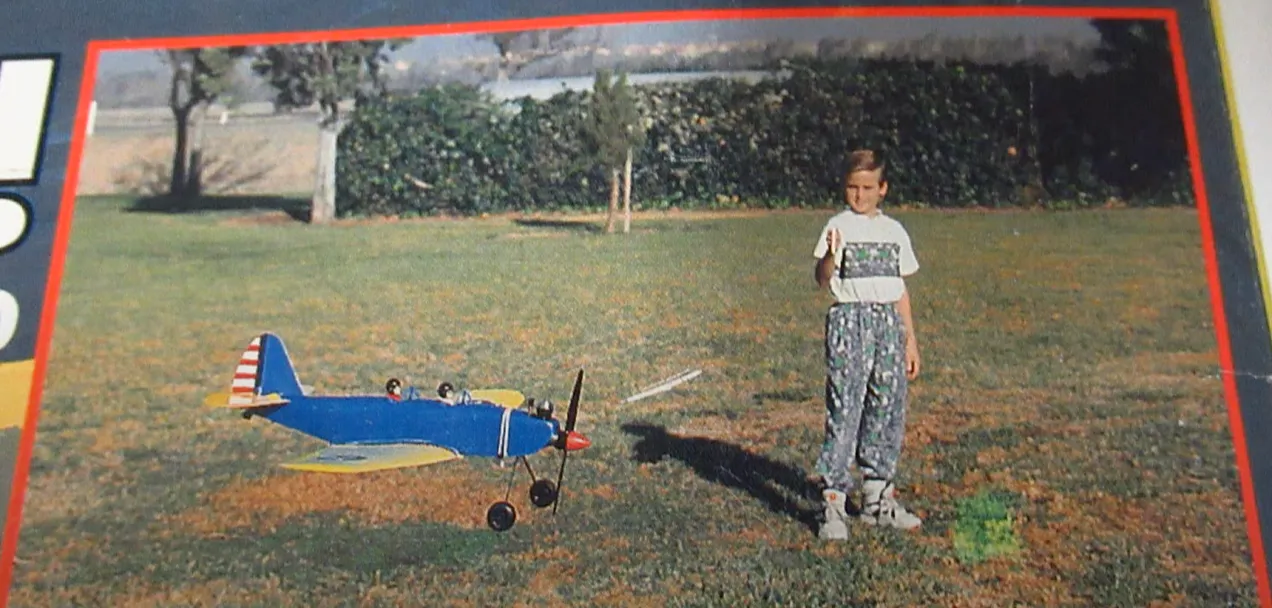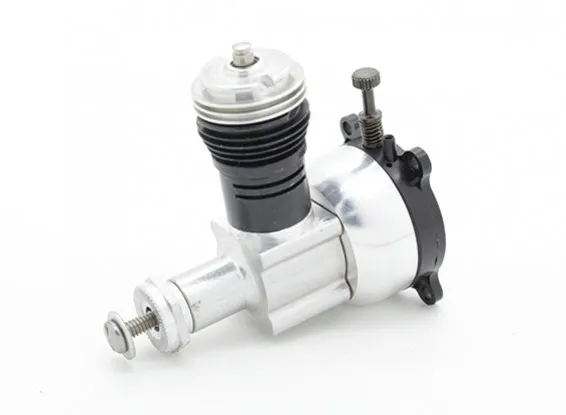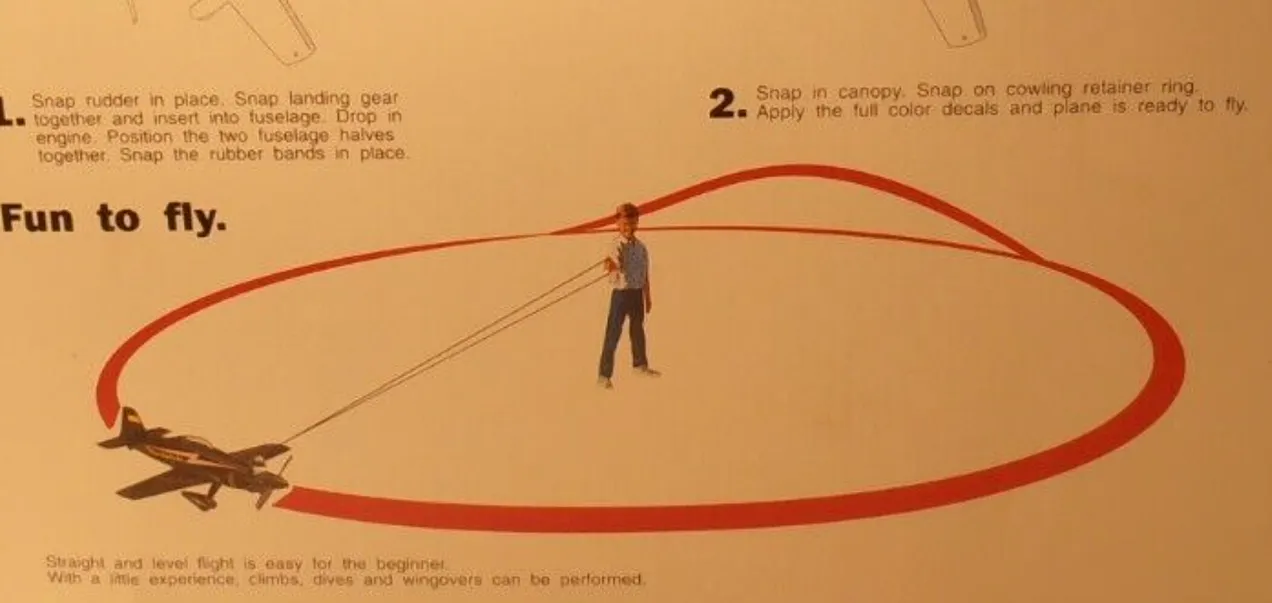
Posted on 07/24/2025 7:51:23 AM PDT by Red Badger

Mark here. It’s hard to exaggerate the allure of the Cox E-Z Flyer. To a young boy in the late 1970s, the Cox E-Z Flyer was the best toy in the world. It was also loud, dangerous, and doomed.
Why Is This Interesting?
The Cox E-Z Flyer was a control-line model airplane powered by a tiny internal combustion engine. It was attached to two 50’ control lines that ran to a handle. The model airplane enthusiast would hold the handle as the plane spun in a 100’ diameter circle around the pilot until it ran out of fuel or crashed. These two outcomes were equally likely.
Theoretically, the control lines allowed the pilot to perform tricks and maneuvers with the plane by tilting the handle to manipulate the plane’s control surfaces. However, as a practical matter for most Cox EZ-Flyer owners, this illusion of control only served as a temptation to stray from the only prudent flight plan, which was level flight until fuel exhaustion.
Did the pilot get dizzy? Yes.
Could a passerby get snared in the spinning control line such that the plane circled closer and closer on an ever-tightening death spiral until the whirling propeller and the incandescently hot metal engine collided with its victim? Theoretically, I guess. But it seems more likely that the plane would lose vertical control and crash long before this, leaving the pilot and the victim to explore concepts such as fault, responsibility, and liability.
Because the Cox E-Z Flyer began its inexorable motion immediately upon starting, it required two people to operate: the pilot and someone to start the plane. Starting a Cox E-Z Flyer had its own challenges and dangers. The starter would hand-crank the tiny, sharp propeller like an old-time barnstormer. A small spring hooked around the propeller. The starter would spin the propeller backward against the spring, then flick it to release the prop, hoping the engine would kick into life. Frequent mis-starts encouraged the starter to ever more enthusiastic prop-flicking, which increased the chances that when the tiny engine burst into life, the starter’s fingers would be in the path of the propeller. Typing this paragraph vividly evokes the sting of a fresh cut on gasoline-soaked fingers.
Starter/crowd control was this writer’s assigned serfdom—since the Cox E-Z Flyer that came (briefly) into our house was the property of my eleven-year-old brother. At age nine, all I got to do was struggle to start the plane and then hold back the curious neighbors, dogs, and occasional motor vehicle traffic as my brother spun his orbits around our cul-de-sac.
My crowd control efforts were made easier by the shockingly loud buzz emitted by the tiny 0.049 cubic inch two-stroke engine. These adorable powerplants are called “glow plug” engines because the fuel is ignited by the glowingly hot engine itself. In the unlikely event of a successful flight, the enthusiastic pilot would no doubt want to fly again immediately, leaving the starter to try to refuel and re-prop an engine that was literally hot enough to ignite its own fuel. A precise blend of fuel and lubricant was required, both helpfully sold and supplied by the Cox Model Engine Company.

Cox 0.049 cubic inch glow plug engine
One day, after my brother had pulled off another flawless full-tank-to-exhaustion rotating flight on our cul-de-sac, I managed to wheedle and whine enough to get him to allow me to fly his plane. Our very poor idea was for him to begin the flight (I’d prop and start the plane as usual), then I’d dash to the center of the 50’ radius, grab the control handle from him, and continue the flight. This did not go as planned. The moment of slack created when we handed off the controls sent the plane into a climb, then an unrecoverable dive. The little plane crashed into the pavement and burst into dozens of pieces of sharp plastic and hot metal. My relationship with my brother suffered similarly irreparable damage.
Control line model aviation is a rich and rewarding hobby pursued with great skill and care by enthusiasts all around the world. The Cox E-Z Flyer may have been an excellent model for the hobbyist, but as a toy for children, it was terrible, sure to end its short service life in tears and flame. You may be thinking that the Cox E-Z Flyer was never intended for children and that it only fell into the hands of kids who adroitly manipulated their parents into buying them a gift intended for adults. But no, dear reader. Take a look at this:

This is the back of the box for the Cox E-Z Flyer. How old is that hobbyist? Nine?
The Cox Hobbies company merged with the equally exciting Estes Model Rockets in 1996, but competition from inexpensive electric-powered, radio-controlled aircraft spelled the end of production soon thereafter. Dedicated fans of Cox’s tiny internal combustion engines keep a market alive for parts and fuel, and Cox E-Z Flyers are available from time to time on eBay. Serviceable models can be found for about $200. (MJS)
Quick Links: (AT SITE)
This introductory video for control-line flying, “Wired for Excitement”, is narrated by the great John Facenda of NFL Films fame. (MJS)
Brodak.com covers all things related to control-line flying (MJS)
The Wikipedia page for the Cox model engine (MJS)
First flight video of a New-In-Box Cox E-Z Flyer of the same type and model that I famously crashed. “They don’t make educational toys like this anymore”- Educational? (MJS)
Thanks for reading,
Noah (NRB) & Colin (CJN) & Mark (MJS)
==============================================================
Mark Slavonia (MJS) is an investor, a pilot, and an avid cyclist. He wrote about radio altimeters, rowing machines, traveler’s checks, and more. He posts other things that are interesting on his website.
=============================================================
Aviation Ping!.....................
I remember this.
My father got me one for Xmas, a P-51.
We set it up outside.
I told my father the instructions said to set min throttle till one got used to it.
He ignored me. Plane took off, went vertical and looped noesdown into the ground.
I can still smell the Cox Gas!..................
He mentions model Rockets. I really enjoyed the Estes rockets with my kids.
Had many of those as a child.
Several of the P-19 flight trainer as well as the Stuka dive bomber and P-40 War Hawks.
Crashed and destroyed all of them eventually. No child was ever injured by mine. Glad I grew up in a time where I wasn’t overly protected and actually had opportunity to explore and experience unique things.
My first flight with this airplane it immediately crashed nose first into the ground. Repaired the broken wings as best I could. A couple of weeks later ...again nose first into the ground. there was no real control of the craft with those controls.
We eventually mounted the .049 onto a block of wood, and attached that to a roller skate. That went poorly.
Lawn darts
>>>...there was no real control of the craft with those controls.<<<
I think that was intentional!....................
Klik klaks
I also had the P-51.
It briefly flew once before disintegrating on impact. I still have the engine.
We had a couple of those back in the day, and I built a balsawood model (P-40 Warhawk). I think at one time I had three .049 engines in my collection.
A friend of mine tried to hold the engine while it ran............Didn’t...............
These go back much earlier than the 70s. I tried to fly them in the early 60s. Well it did fly, but not for long.
Oh man I remember these. My dad bought one when I was about 5. Around 1972/73. It was not this aircraft, it was a P-47. The fuselage was basically two dimensional, just a balsa cutout. But looked really cool. My dad did a nice job, painted it silver and put on all the decals. Lil’ Brown Jug was the nickname painted on the cowling. He flew it pretty well but I cracked it up numerous times. He would patiently repair and repaint it. He even repaired it when I really augured in hard and fractured the plastic firewall for the .049 engine. Good times.
I had one of the Cox propeller-driven tether cars for quite a while. I still remember the shattered thumbnail from getting a bit careless when adjusting that little mixture screw. What fun.
While in high school, I passed by the school yard and saw a friend flying a control-line model plane with a .049cc engine. I went over to watch him perform loops and saw that he was pretty capable at handling the plane. He said it was easy and told me to give it a try with one of his two planes that he had with him. After he re-fueled the one he had been flying, he handed me the control lines and started up the engine. Two seconds into flight, it went up and then down into the ground. While I was apologetic and embarrassed, he seemed to not mind at all and insisted that I give it another try with the other plane he had with him. I was reluctant, but two seconds into that flight, another nose-dive and crash. I think he was a bit upset after that, but I don’t recall him trying to strangle me with the limp control line...
Disclaimer: Opinions posted on Free Republic are those of the individual posters and do not necessarily represent the opinion of Free Republic or its management. All materials posted herein are protected by copyright law and the exemption for fair use of copyrighted works.